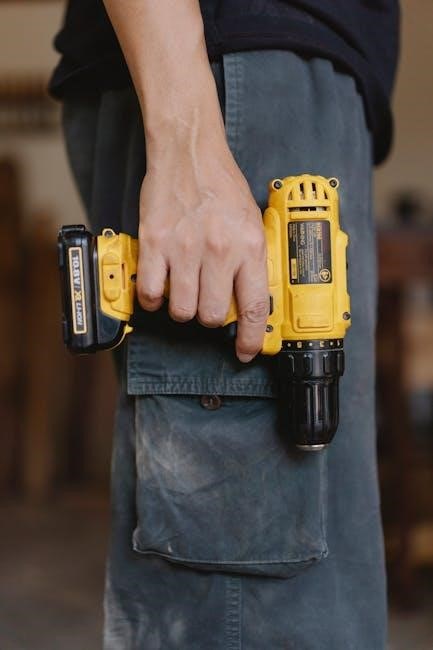Altivar 61 Manual: A Comprehensive Guide
Welcome to the comprehensive guide for the Altivar 61. This manual provides essential information for users seeking to understand, install, operate, and maintain their Altivar 61 drive systems effectively, ensuring optimal performance.
The Altivar 61 is a variable speed drive designed for asynchronous motors, catering to a broad range of power requirements. This drive is commonly used in applications such as HVAC systems, offering advanced control and energy efficiency. Before installation or operation, thoroughly review this manual to ensure safe and correct usage. Installation, adjustment, and maintenance should only be carried out by qualified personnel, adhering to all international and national electrical codes, including proper grounding.
This comprehensive guide provides essential information for understanding the Altivar 61, including its features, functions, and operational parameters; It covers topics ranging from initial setup and wiring to programming, troubleshooting, and preventative maintenance. Additionally, this manual offers guidance on migrating from older Altivar models, ensuring a smooth transition. Whether you are a new user or an experienced technician, this manual serves as a valuable resource for maximizing the performance and longevity of your Altivar 61 drive system.

Installation Guide
This section details the installation process for the Altivar 61, covering mounting instructions, wiring procedures, and initial setup. Ensure all steps are followed carefully by qualified personnel.
Initial Setup and Mounting Instructions
Before commencing the installation, it’s crucial to inspect the Altivar 61 for any signs of damage incurred during shipping. Ensure the mounting location is clean, dry, and adequately ventilated to prevent overheating. The drive should be mounted vertically on a flat, stable surface capable of supporting its weight. Maintain the recommended clearances around the drive for proper airflow.
Verify that the ambient temperature and humidity are within the specified operating range. Use appropriate hardware for mounting, ensuring secure attachment to prevent vibration. Connect the grounding conductor to the designated grounding terminal before any other electrical connections.
Double-check all connections according to the wiring diagrams provided in the manual. After physical installation, perform an initial power-up test to confirm basic functionality before proceeding with parameter configuration. Always adhere to safety regulations and electrical codes during the entire process.
Wiring and Connection Procedures
Proper wiring is critical for the safe and efficient operation of the Altivar 61 drive. Begin by disconnecting power to prevent electrical hazards. Use appropriately sized conductors based on the drive’s current rating and local electrical codes. Connect the input power supply, ensuring correct voltage and phase sequence.
Carefully wire the motor leads to the output terminals, following the motor’s nameplate data. Use shielded cables for motor connections to minimize electromagnetic interference. Connect the control signals, such as start/stop commands and speed references, to the designated input terminals.
Verify all connections are tight and secure to prevent loose wiring. Separate power and control cables to reduce noise. Ensure proper grounding to protect against electrical faults. After wiring, double-check all connections against the wiring diagrams in the manual. Apply power and test the drive’s basic functions before proceeding to parameter settings. Always observe safety precautions during wiring.

Programming and Configuration
This section details how to access programming mode, adjust parameters, and utilize the integrated display terminal. It provides the necessary steps for tailoring the Altivar 61 to specific application needs.
Accessing the Programming Mode
To begin configuring your Altivar 61, accessing the programming mode is the first crucial step. This mode allows users to modify parameters, adjust settings, and customize the drive’s functionality to match specific application requirements. Before proceeding, ensure that the drive is in a safe state, with power disconnected if necessary, to prevent any accidental changes or hazards.
The specific method for entering programming mode may vary slightly depending on the model and firmware version of your Altivar 61. Typically, it involves using the integrated display terminal or a connected programming tool. Consult the relevant section of the user manual for detailed, step-by-step instructions specific to your device.
Once in programming mode, exercise caution when making changes. Incorrect parameter settings can negatively impact the drive’s performance or even cause damage. Always refer to the manual for guidance on the appropriate values for each parameter.
Parameter Settings and Adjustments
Within the Altivar 61’s programming mode lies a vast array of adjustable parameters, each controlling a specific aspect of the drive’s behavior. These parameters allow for fine-tuning the drive to optimize performance for various applications, ranging from simple motor speed control to complex process automation. Understanding the function of each parameter is essential for effective configuration.
Before making any adjustments, carefully document the original parameter values. This will allow you to revert to the default settings if needed. The user manual provides detailed descriptions of each parameter, including its valid range and its impact on the drive’s operation. Pay close attention to parameters related to motor control, acceleration/deceleration, protection features, and communication settings.
When adjusting parameters, make small, incremental changes and test the results thoroughly. Monitor the motor’s performance and the drive’s status to ensure that the changes are having the desired effect. Incorrect parameter settings can lead to instability, inefficiency, or even damage to the motor or drive.
Using the Integrated Display Terminal
The Altivar 61 features an integrated display terminal, providing a user-friendly interface for accessing parameters, monitoring drive status, and performing basic operations. The terminal typically consists of a screen and a set of buttons for navigation and selection. Familiarizing yourself with the terminal’s layout and functions is crucial for effective drive management.
The display terminal allows you to view real-time data such as motor speed, current, voltage, and frequency. It also provides access to diagnostic information, including fault codes and alarm messages. By navigating through the menu structure, you can easily adjust parameter settings, switch between operating modes, and perform other essential tasks.
Refer to the user manual for a detailed explanation of the terminal’s menu structure and the function of each button. Practice navigating through the menus and familiarize yourself with the different display screens. With a little practice, you will be able to use the integrated display terminal to quickly and easily manage your Altivar 61 drive.
Operation and Control
This section details operating the Altivar 61, including switching between auto and hand modes and understanding drive functions. Mastering these aspects is vital for efficient motor control and application.
Switching Between Auto and Hand Mode
The Altivar 61 variable frequency drive (VFD) offers both automatic (Auto) and manual (Hand) operating modes, providing flexibility in controlling the connected motor. Switching between these modes allows operators to adapt to varying process demands and operational scenarios. In Auto mode, the VFD automatically adjusts the motor speed based on external signals or pre-programmed settings, ideal for applications requiring consistent performance without manual intervention.
Conversely, Hand mode grants the operator direct control over the motor speed, enabling manual adjustments as needed. This mode is particularly useful during commissioning, troubleshooting, or when specific manual control is desired. The process of switching between Auto and Hand modes typically involves using the VFD’s integrated display terminal or external control devices.
Consult the Altivar 61 programming manual for detailed instructions on configuring and utilizing these modes effectively. Understanding the nuances of each mode ensures optimal control and adaptability in various industrial applications.
Understanding Drive Functions
The Altivar 61 drive boasts a comprehensive suite of functions designed to optimize motor control and enhance application performance. Key functions include motor speed control, torque regulation, and acceleration/deceleration management, enabling precise control over connected motors. Furthermore, the drive incorporates protective functions such as overcurrent protection, overvoltage protection, and thermal overload protection, safeguarding the motor and drive from potential damage.
The Altivar 61 also supports advanced features like PID control, allowing for closed-loop control of process variables such as pressure, flow, or temperature. Communication capabilities, including Modbus and Ethernet, facilitate seamless integration with automation systems for remote monitoring and control. Understanding these drive functions is crucial for maximizing the Altivar 61’s capabilities and tailoring its operation to specific application requirements.
Refer to the programming manual for detailed explanations and configuration instructions for each function, ensuring optimal performance and protection for your motor-driven systems.
Troubleshooting
This section provides guidance on identifying and resolving common issues encountered while operating the Altivar 61. Consult this section for efficient solutions to maintain optimal system performance and minimize downtime.
Common Issues and Solutions
This section addresses frequent problems encountered with the Altivar 61, providing practical solutions for each. One common issue involves drive tripping due to overcurrent, often caused by incorrect motor parameters. Verify these parameters against the motor nameplate data and adjust accordingly within the drive’s settings. Another issue arises with communication errors, potentially stemming from faulty wiring or incorrect network configurations. Ensure proper cable connections and confirm that the communication parameters match those of the connected devices.
Furthermore, users may experience issues with the integrated display terminal, such as unresponsiveness or display errors. In such cases, power cycling the drive or checking the terminal’s connection can resolve the problem. If the drive fails to switch between auto and hand mode, check the control logic and external signals connected to the drive’s inputs. Finally, overheating can lead to drive malfunction, so ensure adequate ventilation and cooling. Regularly inspect and clean the heatsink to prevent dust accumulation. By addressing these common issues promptly, users can maintain the Altivar 61’s reliability and prevent costly downtime.

Maintenance
Proper maintenance is crucial for the longevity and reliable operation of your Altivar 61 drive. This section outlines essential maintenance practices to keep your drive functioning optimally and avoid unexpected failures.
Preventative Maintenance Tips
To ensure the long-term reliability and optimal performance of your Altivar 61 drive, implementing a proactive preventative maintenance program is essential. Regularly inspect the drive for any signs of physical damage, such as cracks or deformities in the housing. Check all connections to ensure they are secure and free from corrosion, tightening any loose terminals.
Keep the drive clean by removing dust and debris from the heatsink and ventilation openings using a soft brush or vacuum cleaner. Verify that the cooling fan is functioning correctly and is free from obstructions. Monitor the drive’s operating temperature and ensure it remains within the specified limits.
Periodically check the input voltage and current to ensure they are within the acceptable range. Inspect the motor cables for any signs of wear or damage. By following these preventative maintenance tips, you can significantly extend the lifespan of your Altivar 61 and minimize downtime.

Migration from Altivar 38
This section guides users through upgrading from the Altivar 38 to the Altivar 61. Learn about key differences and how to replace your older drive with the newer model.
Differences Between Altivar 61 and Altivar 38
The Altivar 61 presents several key advancements over the Altivar 38. The ATV61 boasts enhanced performance capabilities, including improved motor control algorithms and faster processing speeds, offering superior responsiveness. Furthermore, the ATV61 includes advanced communication options, supporting modern industrial networks for seamless integration into existing systems.
Energy efficiency is another significant upgrade. The ATV61 incorporates features that minimize energy consumption, reducing operational costs and environmental impact. In terms of usability, the ATV61 offers a more intuitive user interface with enhanced diagnostic tools, simplifying setup and troubleshooting.
Finally, the ATV61 provides expanded protection features, safeguarding against electrical faults and overloads, ensuring greater reliability and longevity. These differences make the Altivar 61 a compelling upgrade.
Replacing Altivar 38 with Altivar 61
Upgrading from an Altivar 38 to an Altivar 61 requires careful planning and execution. Begin by documenting the existing wiring configuration of the Altivar 38 to ensure accurate replication. Next, remove the ATV38, paying attention to safety protocols and disconnecting power sources.
Install the Altivar 61 in the same location, using compatible mounting hardware. Reconnect the power and motor cables, adhering to the wiring diagram. Configure the ATV61 parameters to match the settings of the ATV38, adjusting for any differences in functionality.
Test the system thoroughly after installation. Monitor motor performance and verify that all safety features are functioning correctly. Finally, consult the Altivar 61 manual for detailed instructions and troubleshooting tips. This process ensures a smooth transition.